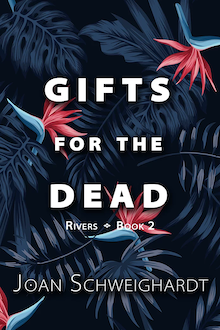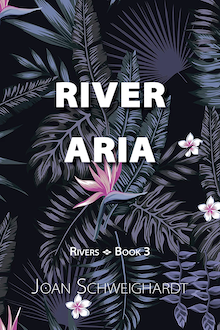Our Research Notes series invites authors to describe their process for a recent book, with “research” defined as broadly as they like. This week, Joan Schweighardt writes about her Rivers Trilogy (Before We Died, Gifts for the Dead, and River Aria) published by Five Directions Press.
+
Spelunking From My Desk
 If you had asked me even a couple of months ahead if I would like to research and write fiction based on the South American rubber boom that occurred in the early 20th century, I would have said, No, thank you; not really my cup of tea. But then two things happened, almost simultaneously, and my desire to immerse myself in the subject jumped from zero to ten.
If you had asked me even a couple of months ahead if I would like to research and write fiction based on the South American rubber boom that occurred in the early 20th century, I would have said, No, thank you; not really my cup of tea. But then two things happened, almost simultaneously, and my desire to immerse myself in the subject jumped from zero to ten.
First, I was hired by a publisher to review some of their backlist books and write fresh descriptions of them for their website. One of the books (White Gold) was a diary written by an actual early 20th century rubber tapper, edited and annotated years after the fact by a leading figure in the ethnobotany of the Amazon Basin. The book was fascinating. I had given rubber tapping not a single thought in my entire life until I read it. Now we have synthetic rubber, and if we want the real thing, we can get it from rubber plantations in Southeast Asia. But back then, a hundred plus years ago, and following a sharp increase in the demand for rubber due to the advent of the world’s first automobiles, the only way to get rubber was from rubber trees in the rainforest, and collecting it was a dangerous business.
The rainforest is as beautiful as it is threatening. Being a Tarzan devotee since childhood, I had always wanted to visit a rainforest and might have sooner if not for the fact that I was deathly afraid of snakes and spiders. Then, at the very time that I was re-reading the rubber tapper’s intriguing diary, the second thing happened. I was watching a PBS special wherein a journalist traveled to the South American rainforest to ask a shaman/chief from one of the then recently contacted tribes what Northerners could do to help protect the rainforest from the byproduct drillers and miners were leaving in their wake. The shaman/chief said, through a translator, that Northerners could “change the dream.”
Change the dream. What did that mean? I googled the phrase and it took me to the website of an organization that regularly brings small groups of environmental/sustainability advocates into the deep jungle to meet with tribal people and learn firsthand not only about their culture but also about the challenges they face — and the world will come to face — if the rainforests aren’t protected. In return for the host tribe’s hospitality, the organization provides legal services (and more) that the tribal people would never be able to acquire on their own. I contacted the organization immediately, before I had the time to consider snakes, spiders or anything else, and signed up not only myself but also my only-too-happy-to-come-along environmentalist and photographer husband. And not long after, we traveled to the deepest part of the Ecuadorian rainforest to meet with people who had been headhunters some twenty-five years earlier.
 The obsession that would take hold of me for the next decade was a combination of those two events — the reading of White Gold and the trip to Ecuador. By the time we boarded the first of the planes that would take us home from Ecuador, I was already so anxious to write — something, anything — about the magnificence of the rainforest that I actually bruised my computer-faithful hand scribbling for pages and pages in a notebook in longhand. I ignored the pain, and a year later Parabola Magazine published a cleaned-up version of what I wrote, in a ten-page spread that included my husband’s amazing photos. But it wasn’t enough, so I began a novel that would include the rubber boom, and the novel wouldn’t end, so I wrote a trilogy.
The obsession that would take hold of me for the next decade was a combination of those two events — the reading of White Gold and the trip to Ecuador. By the time we boarded the first of the planes that would take us home from Ecuador, I was already so anxious to write — something, anything — about the magnificence of the rainforest that I actually bruised my computer-faithful hand scribbling for pages and pages in a notebook in longhand. I ignored the pain, and a year later Parabola Magazine published a cleaned-up version of what I wrote, in a ten-page spread that included my husband’s amazing photos. But it wasn’t enough, so I began a novel that would include the rubber boom, and the novel wouldn’t end, so I wrote a trilogy.
Research was required to put the first few characters that occurred to me into the deep jungle where they could have their own adventure tapping rubber trees. And research, as those of us who love it know, not only provided the details I needed to be historically accurate but also illuminated great expanses of an extremely rich history I needed to grasp to be able to move forward — and backwards — in time.
The history of the rubber boom includes the story of a cunning Brit who stole some 70,000 rubber tree seeds from South America and shipped them to England before my novel even begins. The progeny of those same seeds would later grow on plantations in Southeast Asia, bringing the rubber boom in South America to a very abrupt end. But in the interim, a central hub was needed to take the gathered rubber out of the rainforest and bring it to ports in New York and London. Since the sleepy fishing village of Manaus, Brazil was centrally located in the middle of the Amazon basin, on a part of the Amazon River that had the depth necessary to host the ships that would need to come and go, that was where the entrepreneurs, mostly from Europe, headed once they saw the potential to make a fortune in the rubber industry. Their greed was boundless though, and when they realized that many of their non-native rubber tapper recruits were dying of malaria, snake bites, starvation, etc., some began enslaving indigenous people to do the work. If not for the plantations in Southeast Asia, which had by then become productive, the situation could have gotten much worse much sooner.
I made a second trip to Manaus in Brazil, to get a feel for the magnificent city that had been built in the middle of the rainforest by the rubber barons and then quickly abandoned when the boom ended. The Teatro Amazonas, the grand opera house they hoped would attract world-famous performers, would become fodder for my third book. I also traveled the Amazon and Rio Negro with a guide to see, among other things, rubber trees.
I decided that my characters who visit the rainforest would be from Hoboken, New Jersey, because Hoboken has docks from which they could sail to South America, and because I grew up not far from there and knew the lay of the land. Research alerted me to the fact that the immigrants in Hoboken in the time I was interested in were either German, Irish or Italian. I made the decision that my characters would be first generation Irish Americans… and so on.
 For me, researching for historical fiction is like spelunking. You enter the cave of your choice and begin to search for those exquisite details that will bring your story to historical life. Most caves are not simply linear chambers that lead you from an entrance to an exit or turn-about point. There are sub-chambers, and sub-sub chambers and so on. You never know where you’re going to wind up or what you’re going to find. In many cases the chambers you discover will not only enrich your story but they will actually point the way to plot points you hadn’t thought of.
For me, researching for historical fiction is like spelunking. You enter the cave of your choice and begin to search for those exquisite details that will bring your story to historical life. Most caves are not simply linear chambers that lead you from an entrance to an exit or turn-about point. There are sub-chambers, and sub-sub chambers and so on. You never know where you’re going to wind up or what you’re going to find. In many cases the chambers you discover will not only enrich your story but they will actually point the way to plot points you hadn’t thought of.
While the first book in my trilogy is about two brothers who go to the rainforest to tap for rubber, the second is about the one who returns, and the impact his solitary reappearance has on the characters who were left behind in Hoboken in the first book. By then women’s suffrage is in full swing and WWI, in which Hoboken played an astonishingly big part (to return to my spelunking metaphor, choosing Hoboken was like finding a chamber full of shimmering crystals), is in the offing. And by the third book, when the Manaus-born daughter of one of the brothers makes her way from South America to New York, Prohibition, rum-running, speakeasies and jazz are defining the times, and the Great Depression is on the brink.
My research took me into all these chambers and sub-chambers and more. I learned things I didn’t know before, and I learned new details about the ones I thought I knew enough about already. As Robert Henri says in his book The Art Spirit (another sub-chamber I found myself exploring),“The object of all art is intense living, fulfillment and great happiness in creation.” That’s what I experienced writing the Rivers Trilogy.
+++